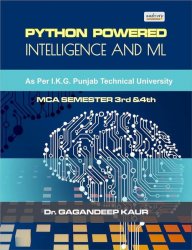Python Powered Intelligence and ML: A Comprehensive Guide to AI and Soft Computing
- Добавил: literator
- Дата: 27-02-2024, 15:01
- Комментариев: 0
 Название: Python Powered Intelligence and ML: A Comprehensive Guide to AI and Soft Computing
Название: Python Powered Intelligence and ML: A Comprehensive Guide to AI and Soft ComputingАвтор: Gagandeep Kaur
Издательство: AMKCORP Research Technologies PVT LTD
Год: 22-10-2023
Страниц: 421
Язык: английский
Формат: pdf, epub, mobi
Размер: 10.1 MB
Python Powered Intelligence And ML is designed to be your essential companion in your journey through the world of Artificial Intelligence and Python programming. We understand the importance of building a solid foundation in AI concepts, as well as mastering the tools and techniques needed to implement AI solutions effectively.
Artificial Intelligence (AI) is the branch of computer science dedicated to creating systems that can perform tasks typically requiring human intelligence. It encompasses a wide range of techniques, algorithms, and technologies that enable computers to mimic or replicate human-like cognitive functions. These functions include problem-solving, learning, reasoning, understanding natural language, recognizing patterns, and making decisions. AI is a multifaceted field that includes various subfields and applications. It covers everything from machine learning, deep learning, and natural language processing to robotics and computer vision. The scope of AI continues to expand as technology advances and new challenges emerge.
Machine Learning is a subset of AI that focuses on the development of algorithms that enable computers to learn from data and make predictions or decisions. It has found widespread application in areas like predictive analytics, recommendation systems, and fraud detection.
Supervised Learning: In supervised learning, models are trained on labeled data to make predictions or classify new data points. Linear regression and decision trees are common supervised learning techniques.
Unsupervised Learning: Unsupervised learning involves finding patterns and structure in data without labeled examples. Clustering and dimensionality reduction techniques fall under this category.
Reinforcement Learning: Reinforcement learning is used for training agents to make sequential decisions by interacting with an environment. It has applications in robotics, gaming, and autonomous systems.
Deep Learning: Deep Learning is a subset of Machine Learning that uses artificial neural networks to model complex patterns in data. Convolutional Neural Networks (CNNs) and Recurrent Neural Networks (RNNs) are examples of Deep Learning architectures.
What You’ll Find Inside:
Foundation of Artificial Intelligence: In Chapter 1, we lay the groundwork for your AI education, providing a strong understanding of the fundamentals.
Knowledge Presentation: Chapter 2 delves into how knowledge is represented in AI systems, a crucial element for creating intelligent machines.
Informed / Heuristic Search Strategies: Chapter 3 explores strategies for problem-solving and decision-making, crucial in the AI domain.
Natural Language Processing: In Chapter 4, we dive into the world of language understanding and processing, a key area of AI.
Soft Computing: Chapter 5 introduces the concept of soft computing, which enables AI systems to work with uncertainty and imprecision.
Neural Networks: Chapter 6 covers neural networks, a fundamental technology in modern AI, inspired by the human brain.
Fuzzy Systems: Chapter 7 is all about fuzzy logic, which allows AI systems to deal with vagueness and uncertainty.
History of Genetic Algorithms: Chapter 8 takes you through the fascinating history and principles of genetic algorithms.
Regression: In Chapter 9, we explain regression techniques for predictive modeling, a crucial tool in AI.
Python Programming: The second part of Python Powered Intelligence And ML focuses on Python, one of the most versatile and popular programming languages.
Numpy: Chapter 11 introduces the powerful library for numerical computing in Python.
Pandas: In Chapter 12, we explore Pandas, a tool for data manipulation and analysis.
Matplotlib: Chapter 13 introduces you to data visualization using Matplotlib.
Regression: We revisit regression in Chapter 14, providing more insights and applications.
Our aim is to empower you with the knowledge and skills to excel in Artificial Intelligence and Python programming. Whether you are a beginner or an experienced programmer, this book is your go-to resource for AI and Python. We hope you enjoy this journey with us, and may it inspire you to explore the exciting world of Artificial Intelligence and Python programming. Happy learning!
Скачать Python Powered Intelligence and ML: A Comprehensive Guide to AI and Soft Computing
Внимание
Уважаемый посетитель, Вы зашли на сайт как незарегистрированный пользователь.
Мы рекомендуем Вам зарегистрироваться либо войти на сайт под своим именем.
Уважаемый посетитель, Вы зашли на сайт как незарегистрированный пользователь.
Мы рекомендуем Вам зарегистрироваться либо войти на сайт под своим именем.
Информация
Посетители, находящиеся в группе Гости, не могут оставлять комментарии к данной публикации.
Посетители, находящиеся в группе Гости, не могут оставлять комментарии к данной публикации.
